You are looking : INFORMATION Furniture Design History READ NOW
Link article : INFORMATION Furniture Design History READ NOW
Article Furniture, Article furniture design, Article furniture design history, Article furniture history, Article furniture images, Article furniture timeline,
INFORMATION Furniture Design History READ NOW
Furniture design has been a part of the human experience since the beginning of history. Evidence of furniture survives from as far back as the Neolithic Period in the form of paintings, wall Murals discovered at Pompeii, in sculpture and examples have also been excavated in Egyptian Pyramids and found in tombs in Ghiordes (modern day Turkey). These notes will track the main advancements, developments, styles and materials in furniture design highlighting the identifying features of each period, the materials used and show images of some of the most significant pieces of furniture ever designed. The furniture design timeline below outlines just some of the different periods of furniture design and gives you a basic overview of the timeline of furniture design history. Choose from the menu below to look at one furniture design period in more depth.
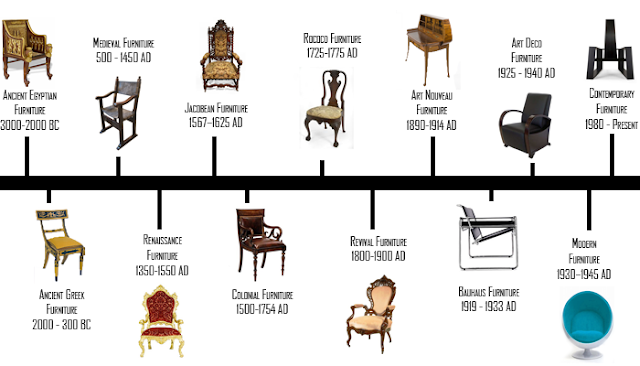 |
| Furniture Design History Timeline |
Neolithic Period Furniture:
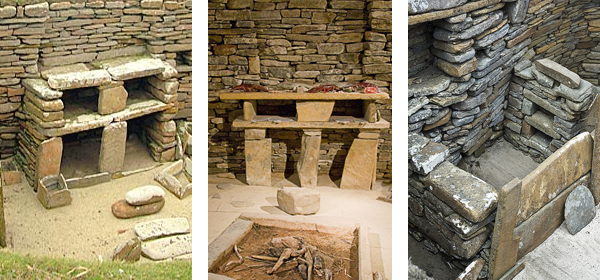 |
| Neolithic Period Furniture |
A excavated site dating from 3100-2500 BC in Skara Brae, Orkney uncovered a range of stone furniture. Due to a shortage of wood in Orkney, the people of Skara Brae were forced to build with stone, a readily available material that could be turned into items for use within the household. Each house was equipped with an extensive assortment of stone furniture, ranging from cupboards, dressers and beds to shelves and stone seats. The stone dresser was regarded as the most important as it symbolically faced the entrance in each house and is therefore the first item that was seen when entering a house.
Ancient Egyptian Furniture:
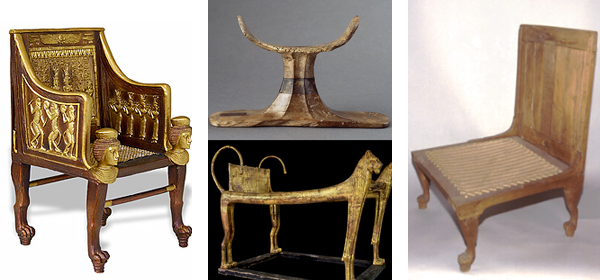 |
| Ancient Egyptian Furniture |
The hyperarid climatic conditions of Egypt since the third millennium BC are perfect for the preservation of organic material. Thanks to these conditions Ancient Egyptian furniture has been excavated and various sites and includes 3rd millennium BC beds, discovered at Tarkhan, a 2550 BC gilded bed and chairs from the tomb of Queen Hetepheres, and boxes, beds and chairs from Thebes. There were two severe sides to the furniture excavated, the intricate gold gilded ornate furniture found in the tombs of the Pharaohs and the simple chairs, tables and baskets of the ordinary Egyptians.
Ancient Greek Furniture:
 |
| Ancient Greek Furniture |
Ancient Greek furniture design can be dated back to the 2nd millennium BC, including the famous klismos chair. The furniture designs are preserved not only by the examples still in existance, but by images of them depicted in Greek vases. In 1738 and 1748 excavations of Herculaneum and Pompeii revealed perfectly preserved Roman furniture. The ashes from the eruption at Mount Vesuvius preserved the furniture from 79 A.D. right up its excavation in the eighteenth century. Characteristic of this early furniture were highly influenced by the furniture of the ancient Egyptians with a stiff, rectangular, and unflattering shape. In the 4th and 5th centuries, once the Greeks developed their own style, furniture became less square and rigid and more curved and flowing.
Medieval Furniture:
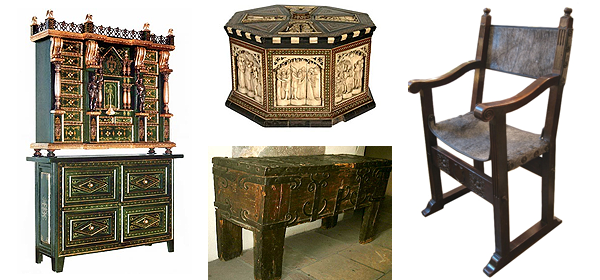 |
| Medieval Furniture |
The medieval period was a stark and somewhat crude time, and that is reflected in the furniture styles of the era. The furniture of the medieval period is very distinctive in style. Its most notable characteristics are ornate wood carvings on the border of chairs and canopy beds, garish structural layouts and colours that are basically grey, beige or black. Forms were mainly square or rectangular with very little in the way of curved lines or circular forms.
Renaissance Furniture:
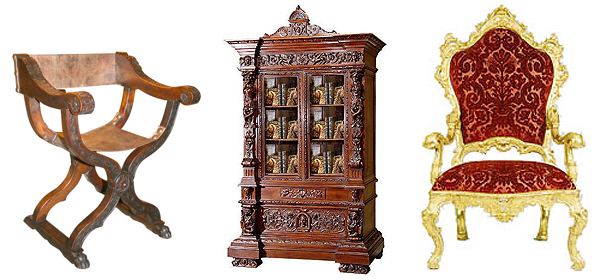 |
| Renaissance Furniture |
Along with the other arts, the Italian Renaissance of the fourteenth and fifteenth century marked a rebirth in furniture design, often inspired by the Greco-Roman tradition. Starting in the fifteenth century, a similar renaissance of culture, occurred in Northern Europe, particularly in the Netherlands, Belgium and Northern France. These designs were distinctly different from that of Medieval times and were characterized by opulent, often gilded designs that frequently incorporated a profusion of floral, vegetal and scrolling ornamentation. The aim of these pieces were often to showcase the skills of the craftsmen who made them.
Jacobean Furniture:
 |
| Jacobean Furniture |
After the Renaissance there was a gradual change to a less ornamented, quieter style of furniture. In Britain table legs, for example became straighter and narrower than were typical of earlier pieces and instead spiral turned legs became typical of this period. In general furniture profiles became lower and more rectangular. Later Jacobean furniture, during the era of Oliver Cromwell the Protector, was very stern, square, and frugal, a suitable style for a time of relative poverty. But with the return of the monarchy under Charles II, Carolean furniture once again became more ornate, characterized by intricate carved stretchers and colourful upholstery with tasselled trim.
By the end of the period, the influence of the British William and Mary style was beginning to show. Compared to the Jacobean and Carolean pieces this style of furniture was lighter and more elegant. Inverted, cup-turned legs, bun feet, and serpentine stretchers made this a very identifiable style.
Colonial furniture:
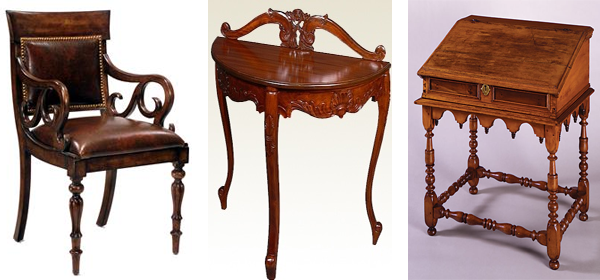 |
| Colonial Furniture |
Across the water in the United States, during the early Colonial period, most furniture arrived along with the first immigrants. They brought furniture pieces typical of the Jacobean and Carolean periods in Britain with them, and then later made their own furniture in a similar style. These pieces were generally sturdy and heavily carved, many with turned legs and bun feet. In the harsher environment of some of the Colonies these pieces were simpler representatives of their parent styles, befitting the more straightforward and utilitarian life of the settlers.
Other settlers also brought their influences with them to the colonies, most notably the Dutch and French in the North east, and the Spanish in the South west. Although recognisably different from the British inspired designs, the Dutch pieces are essentially in the same tradition. However the different climate and different wood available to Spanish colonists led to a distinctly different style known as Mission or South western.
The earliest American-made piece of furniture is a chest made by Nicholas Disbrowe around 1660. Uncompromisingly rectangular, its distinctively carved frame-and-panel construction, although very reminiscent of earlier British Age of Oak pieces, is already recognizable as a distinct American style. Many other early Colonial era pieces, such as wainscot chairs and heavy joint-tables, are similarly in the Age of Oak tradition.
Rococo Furniture:
 |
| Rococo Furniture |
In the eighteenth century, furniture design began to develop rapidly, although there were some styles that belonged primarily to one nation, such as Palladianism in Great Britain or Louis Quinze in French furniture, others, such as the Rococo and Neoclassicism were commonplace throughout Western Europe. In reality the term '18th-century furniture' therefore refers to a wide variety of styles including William and Mary, Queen Anne, Georgian, Chippendale, Hepplewhite, Sheraton, Adam, Regency, Federal, and the French periods of the several Louis, Directoire, and Empire.
While seperate, all 18th-century furniture, whether American, British, or French shared a similar style of construction that is distinct from the subsequent mass-produced furniture of the 19th century. Eighteenth-century furniture is commonly thought of as representing the golden age of the highly trained master cabinetmaker, trained in the craft of furniture design which manifests in highly finished, sophisticated designs.
Revival Furniture:
 |
| Revival Furniture |
The 19th century was marked by the Industrial Revolution, which caused profound changes in society. With increasing working populations in cities, the rise of a new class of wealthy of furniture buyers, together with the arrival of mass-production and the demise of the individual craftsman-designer, the gradual progression of furniture styles that had developed through the previous centuries was replaced by a raft of imitation or revival styles. These concurrent revival styles, including Gothic revival, Neoclassicism and Rococo revival became easy and inexpensive to manufacture as technology developed during the industrial revolution.
With mass-production technology in place it was a simple matter to graft historically correct ornaments onto all sorts of furniture, thereby making possible for the creation of a continual stream of revival styles to meet the demands of the public. The result was a century of furniture whose common denominator was excessive ornamentation in the form of applied metal or wood carvings, inlays or stencils.
Art Nouveau Furniture:
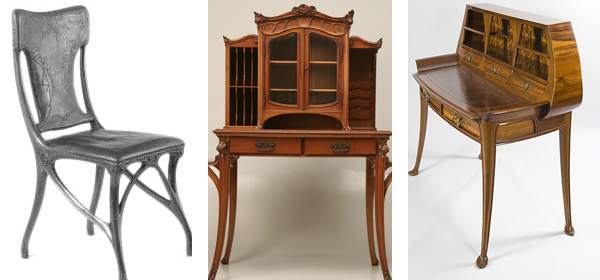 |
| Art Noveau Furniture |
The name "Art Nouveau" is French for 'new art', and it emerged in the late 19th century in Paris. The style was said to be influenced strongly by the lithographs of Czech artist Alphonse Mucha, whose flat imagery with strong curved lines was seen as a move away from the academic art of the time. Art Nouveau furniture used lines and curves as graphical ornamentation and hard woods and iron were commonly used to provide strong yet slim supporting structures to a furniture pieces.
Bauhaus Furniture:
 |
| Bauhaus Furniture |
Because of the greater availability of a wider array of materials than ever before, and because of an ever-expanding awareness of historical and cross-cultural aesthetics, 20th-century furniture is perhaps more diverse, in terms of style, than all the centuries that preceded it. The first three-quarters of the twentieth century saw styles such as Art Deco, De Stijl, Bauhaus, Wiener Werkstatte, and Vienna all work to some degree within the Modernist idiom. The Bauhaus school was founded by Walter Gropius in Weimar in 1919. In spite of its name, and the fact that its founder was an architect, the Bauhaus was founded with the idea of creating a 'total' work of art in which all arts, including furniture would eventually be brought together. The furniture designs that emerged from the Bauhaus became some of the most influential designs in modern design.
Art Deco Furniture:
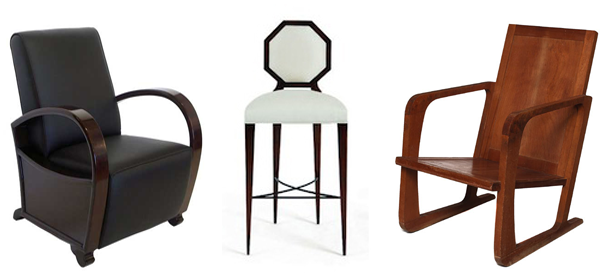 |
| Art Deco Furniture |
The Art Deco movement began in Paris in the 1920s and it represented elegance, glamour, functionality and modernity. Art deco's linear symmetry was a distinct departure from the flowing asymmetrical organic curves of its predecessor style art nouveau. Art deco experienced a decline in popularity during the late 1930s and early 1940s when it began to be derided as presenting a false image of luxury, eventually the style was ended by the austerities of World War II.
Modern Furniture:
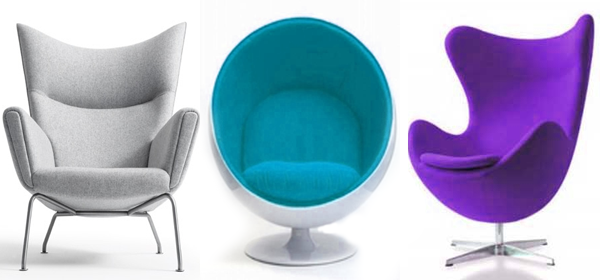 |
| Modern Furniture |
Born from the Bauhaus and Art Deco streamline styles came the post WWII Modern style using materials developed during the war including laminated plywood, plastics and fibreglass. In modern furniture the dark gilded, carved wood and richly patterned fabrics gave way to the glittering simplicity and geometry of polished metal. The forms of modern furniture sought newness, originality, technical innovation, and ultimately conveyed the present and the future, rather than what had gone before it as revival styles had done. This interest in new and innovative materials and methods produced a certain blending of the disciplines of technology and art. The use of new materials, such as steel in its many forms; moulded plywood and plastics, were formative in the creation of these new designs. They were considered pioneering, even shocking at the time especially in contrast to what came before.
Back to Top
Back to Top
So information about INFORMATION Furniture Design History READ NOW
Such articles that discuss INFORMATION Furniture Design History READ NOW, may be useful to you in finding the inspiration to build houses.
You are reading arikel entitled INFORMATION Furniture Design History READ NOW and link this article you can save https://homedesignminimalist1.blogspot.com/2016/03/information-furniture-design-history.html Hopefully information about this is helpful for you.
Tag : Furniture, furniture design, furniture design history, furniture history, furniture images, furniture timeline,
0 Response to "INFORMATION Furniture Design History READ NOW"
Posting Komentar